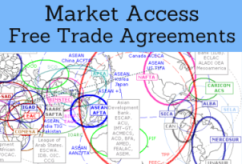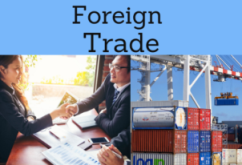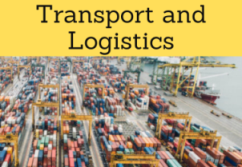Business in Central African Republic
Central African International Trade, Logistics, Bangui. Mining (gold, diamonds)

The Central African Republic: a country in economic transition.
- Mining potential: diamonds, gold, uranium, iron, and petrol
- Agriculture accounts for 55% of GDP in Central African Republic

- Introduction to the Central African Republic (Central Africa)
- Economy of the Central African Republic (CAR)
- International Trade of the Central African Republic
- Case Study:
- Transport in Central African Republic
- Telecommunications
- Kamach Group
- Transport and Logistics
- Access to the Central African Market
- Business Plan for the Central African Republic


The objectives of the subject “Foreign Trade, Logistics and Business in Central African Republic” are:
- To analyze the Central African Economy, Logistics and Global Trade
- To conduct research on business opportunities in Central African Republic
- To explore the Central African trade relations with the student's country
- To learn about Central African Trade Agreements
- To examine the profile of Central African companies
- To develop a business plan for the Central African Market

The Subject “Foreign Trade, Logistics and Business in Central African Republic” is included within the curriculum of the following academic programs at EENI Global Business School:
Master in Business in Africa, Transport and Logistics in Africa, International Business.

Doctorate in African Business.

Module: Business in Central Africa.
Languages:  (
( République centrafricaine
République centrafricaine  Centroafricana
Centroafricana  Centro-africana).
Centro-africana).
- Subject Credits “Doing Business in Central African Republic”: 1

International Trade, Logistics and Business in Central African Republic

Transport and Logistics in Central African Republic
- Nearest Ports:
- Trans-African corridors



Trade Agreements and Preferential Access of the Central African Republic:
- The Central African Republic and the Central African Economic Area
- Economic Community of Central African States (ECCAS)
- Central African Economic and Monetary Community (CEMAC)
- Community of Sahel-Saharan States (CEN-SAD)
- African Continental Free Trade Area
- European Union-Central African Republic
- The United States-Central African Republic
- AGOA
- Conference on the Great Lakes Region
- Harmonization of Business Law in Africa (OHADA)

- World Trade Organization (WTO)
- Agreement on Trade in Services (GATS)
- Agreement on Sanitary Measures
- Agreement on Technical Barriers to Trade
- Agreement on Preshipment Inspection
- Agreement on Safeguards
- Trade Facilitation Agreement
- World Customs Organization (WCO)
- Kyoto Convention (Containers)

African Trade and Economic Organizations. The Central African Republic is a member of:
- Economic Commission for Africa
- African Union
- AU Convention on Preventing and Combating Corruption (not signed)
- AUDA-NEPAD
- African Development Bank
- China-Africa Cooperation
- Africa-India Cooperation
- Africa-BRICS
- Africa-South America Summit
- Afro-Arab Cooperation
- Arab Bank for Africa (BADEA)

- OIC - Observer State
- International Organization of Francophonie
- United Nations
- World Bank
- World Trade Organization (WTO)
- International Monetary Fund
- The Central African Republic (Africa) reached the limit of the Heavily Indebted Poor Countries Initiative
- Poverty is a real phenomenon in Central African Republic: 67% of the population (2,618,000 people) lives below the poverty line
- Main cities in Central African Republic: Bangui (capital), Bimbo, Mbaiki, Berbérati, Carnot, and Bambari Bouar
- Official languages of the Central African Republic: French and Sango
- Central African Population: 5.1 million people
- Area of the Central African Republic: 623,000 km²
- Independence of the Central African Republic: 1960 (France)
- Neighboring countries: Sudan, South Sudan, Chad, Cameroon, the Republic of the Congo, and the Democratic Republic of the Congo
More information: The Central African Republic (EENI African Business Portal).
Religion in Central African Republic.
- African Traditional Religions
- Christianity:
- Catholicism (0.9 million)
- Protestants (0.9 million)
- Islam
The Central African Republic belongs to the Central African Economic Area.

Economy of the Central African Republic.
- Serious political crisis in Central African Republic: Transition Framework (self-proclaimed President)
- Central African Currency: CFA
- Most dynamic sector in Central African Republic: new technologies
- Main crops in Central African Republic: cassava, plantain, maize (corn), coffee, cotton, and snuff
- The Northwest and Centre of the Central African Republic represents a significant agricultural region for the cotton crops and sugar-cane
- Forestry in Central African Republic contributes significantly to the Central African GDP, with extensive tropical timber resources
- Mining (gold) represents another important resource for the Central African Republic regarding the export earnings: official diamond jewellery production (mostly artisanal) was 500,000 carats annually
- The Industrial base is almost non-existent and has not been sufficiently developed in comparison with neighboring countries (such as Cameroon)
(c) EENI Global Business School (1995-2025)
Top of this page








 WhatsApp
WhatsApp